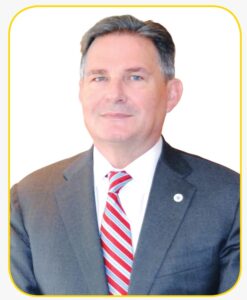Claude Allain, Vice President & General Manager, Middle East & Africa, and Global Vice President, Applied Equipment, Building Technologies & Solutions, Johnson Controls, discusses why it is important to focus on Total Equivalent Warming Impact (TEWI) rather than on Global Warming Potential, and on how he foresees an increase in focus on using higher-efficiency heat- recovery systems to keep a check on increase in load, in view of the call for more fresh air changes to combat COVID-19. Excerpts from an interview he gave to Surendar Balakrishnan of Climate Control Middle East…

Claude Allain
WHAT RECENT INITIATIVES IS JCI ABLE TO REPORT ON ITS CONTRIBUTION TO CLIMATE CHANGE MITIGATION EFFORTS, PLUS THE PROGRESS IT HAS MADE IN FURTHER INCORPORATING ITS LOW-GWP CHILLERS ACROSS BUILDINGS IN THE MIDDLE EAST REGION?
Sustainability has, and will always be, a top priority for Johnson Controls. Our contribution towards creating awareness and promotion of real-world energy savings with the use of variable-speed drives (VSDs) is an initiative that has shown substantial success; the medium-voltage VSD, in particular, was first conceptualised and implemented in the Middle East region. The savings anticipated in pre-sales models have by far exceeded expectations in real-life operation of the early adopter district cooling plants, which have generated repeat applications in other plants and overwhelming interest in other district cooling companies that traditionally did not believe in VSD application.
And the launch of our YZ model is a step towards adoption of low- GWP chillers. When it comes to chillers, our focus as a company has been more on Total Equivalent Warming Impact (TEWI) rather than on low- GWP in isolation. We believe in focusing on real-world energy consumption that impacts CO2 emissions that has very significant – more than 95%– indirect impact on global warming compared to direct impact – less than five per cent – due to refrigerant leakage from a chiller application.
COVID-19 HAS OPENED THE NEED FOR INCREASING THE FOCUS ON IAQ, PERHAPS EVEN SETTING THE STAGE FOR REDRESSING THE IMBALANCE WHEN COMPARED TO THE HEIGHTENED IMPORTANCE GIVEN TO ENERGY EFFICIENCY. WHAT SOLUTIONS AND STRATEGIES ARE YOU CONSIDERING TO INTRODUCE BY WAY OF IMMEDIATELY IMPLEMENTABLE IAQ RETROFIT SOLUTIONS AND OF MEDIUM- AND LONG-TERM SOLUTIONS IN NEW CONSTRUCTION?
In the case of existing buildings, we can see COVID-19 as having a direct impact on the service sector. Many of the existing buildings, especially commercial buildings, are undertaking various measures to improve IAQ. These include incorporating UV light in their AHUs or in their ducting systems; raising awareness of the need for regular maintenance, including changing the filters on a regular basis; improving the efficiency of filters; and introducing portable purification units in halls.
In the case of New Construction, there is no final call on the changes to the codes, but we can sense that there might be consideration that is given to increasing the amount of treated fresh air in the built- environment, according to specific activities or applications. This, in turn, will increase the focus on using higher-efficiency heat-recovery systems, so that there is no substantial increase in the building load. I also see the likelihood of consultants specifying the use of UV lights. I also foresee the introduction of purification systems, such as bi-polar ionisation systems, especially for public-sector applications, like airports, metro stations and halls.
SO, WOULD COVID-19 NOW FORCE THE BUILDING INDUSTRY TO PERMIT MORE FRESH AIR CHANGES PER HOUR, PERHAPS SUBSTANTIALLY MORE THAN THE MINIMUM PRESCRIBED BY ASHRAE? IF SO, WHAT ARE THE CHALLENGES FOR PRODUCT DESIGNERS TO MEET THAT NEED AND YET NOT COMPROMISE ON ENERGY EFFICIENCY FROM TOTAL COST OF OWNERSHIP AND INDIRECT EMISSIONS PERSPECTIVES?
Certainly, the cooling load of the building will go up. The energy required to handle the additional fresh air and exhaust air would increase, as well. Some of it would be compensated by the use of higher-efficiency motors and fans. An additional compensation would be in the form of reduction in chiller energy. However, whether it is entirely compensated to a net-positive-energy saving or not would depend on the amount of increase in the treated fresh air that is supplied to the built-environment.
WHAT FURTHER PROGRESS ARE YOU ABLE TO REPORT ON BUILDING AUTOMATION SYSTEMS IN TERMS OF DIAGNOSTICS AND PREDICTIVE MAINTENANCE? HOW IMPORTANT HAS REMOTE MONITORING OF BUILDINGS BECOME IN A TIME WHEN SOCIAL DISTANCING IS LIKELY TO BE THE NORM FOR AT LEAST TILL THE EMERGENCE OF PREVENTIVE AND CURATIVE MEDICAL INTERVENTION TO PROTECT AGAINST AN AGGRESSIVELY MUTATING VIRUS?
Based on the current pandemic experience, building automation will start playing a key role in keeping viruses – especially airborne ones – out of the built-environment, and in preventing the spread across commercial and residential buildings. So, what will this mean for buildings? Well, I see better filtration – in the forms of cadence around cleaning the filters and the use of high-quality materials for filtration. I also see measurement of air quality across buildings.
I also see a definite role for data analytics – enterprise systems. Indeed, data could play a key role in understanding air quality inside buildings and in monitoring and controlling the spread of such diseases.
Copyright © 2006-2025 - CPI Industry. All rights reserved.